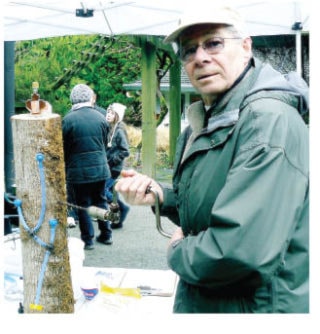Taking a walk in the sugar bush is an experience most Canadians equate with the eastern part of the country, but don’t tell that to Bram Lucieer.
The Black Creek resident and owner of the Vancouver Island Timber Wine Company was on hand at Milner Gardens and Woodland on Sunday to give a demonstration of how even people on the balmy west coast can tap a tree and extract the sap that has become a symbol of Canada worldwide.
“We say ours is better than Quebec,” he said, laughing. “Actually, there’s not much difference, but there’s nothing wrong with the maple syrup produced on the west coast. I’ve met people from back east who have come here to retire and they are amazed at the quality we produce.”
The quality may be the same, but the quantity is not.
“Colder weather would help,” Lucieer said. “We don’t get commercial volumes, but it’s enough for the serious hobbyist to have a good time and produce maple syrup.”
It’s not commercially viable to make maple syrup with the lower volumes of sap available in B.C., but that doesn’t mean there aren’t other options available.
“With syrup, you are reducing the amount when you boil it down by 40 to one,” Lucieer said. “However, with maple wine, one litre of sap makes one litre of wine. That makes it commercially viable.”
The sap has other uses, as well.
“You can make tea out of it,” he said. “You can freeze it in smaller bottles and use it for baking.”
The system he uses to collect the sap might appear strange to people who are fixed on the notion of horse-drawn sleighs pulling up to a tree with metal buckets into which the sap slowly drips. Although he said he harbours some fondness for this traditional image, he has bumped his technology up a notch, favouring large plastic bags over the old-fashioned metal buckets.
“That’s the old-time, romantic approach,” he said. “However, the buckets are an open system and bacteria can get in it and bugs can get in it. This is the first sweet liquid of the season and that’s what the bugs are after. The plastic bags are a closed system, so nothing but the sap goes in.”
Once the sap is collected, he said, it must be processed quickly.
“You have to do it within three days, or the pectin takes over and it goes bad,” he said. “You won’t know it until you boil it down and all of a sudden you’ve got a pot full of jelly.”
At that point, he said, the only option is to throw out the whole batch.
“If you smelled it, you would know why,” he joked.
The actual evaporation process itself is simple, but Lucieer stressed it takes a careful eye.
“Ideally you want direct flame, direct heat underneath the pan where you are evaporating,” he said. “In the early days they had special pans that we shaped to maximize the contact surface between the flame and the pan. Once the sap gets thicker though, you can’t use that method, because it will burn.”
Maple syrup production on the west coast may be a well-kept secret now, but word, Lucieer said, is slowly getting out.
“More and more people are finding out about it and starting to do it,” he said.
There aren’t that many who are following his example and using the sap to make wine on a commercial basis, however.
“I am amazed at how few people have heard of maple wine,” he said. “I found one winery on Prince Edward Island that was producing something very similar to what I do. That was it.”
For more information, call Lucieer at 250-337-5447.
news@pqbnews.com
